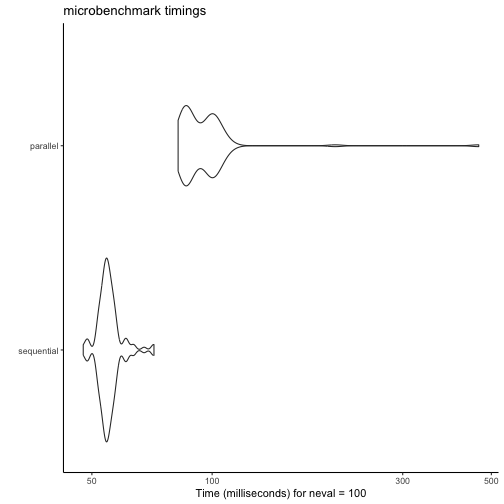You may wish to compare the effects of different establishment dates, different seasons or different locations on disease levels. This vignette details how you can automate several runs of {epicrop} in R and visualise them. Examples are given that show how to run the process sequentially and in parallel, decreasing the runtime necessary and how to benchmark your processes to help optimise your workflow.
Multiple seasons
Fetching NASA POWER data for multiple seasons
Start by creating a list of the dates representing the seasons that
you want to simulate. In this case, since we specify the duration of the
season, there is no need to explicitly state the end-date, that will
automatically be determined by get_wth() with the
duration argument that we pass along in the
purrr::map(). You can use as many start dates, representing
as many seasons as you desire, but for the purposes of speed in this
vignette, only two will be used.
years <- 2000:2001
seasons <- paste0(years, "-06-30")Next use get_wth() to fetch the weather data from the POWER API. In this example we
will use the IRRI Zeigler Experiment Station coordinates as shown in the
example for get_wth(). With the vector of establishment
dates, seasons, use purrr::map() to fetch all
of the seasons with one function. You could also use R’s base
lapply() here as well if you prefer.
library(epicrop)
library(purrr)
seasons_wth <-
map(
.x = seasons,
.f = get_wth,
lonlat = c(121.255669, 14.16742),
duration = 120
)
#> No encoding supplied: defaulting to UTF-8.
#> No encoding supplied: defaulting to UTF-8.
#> No encoding supplied: defaulting to UTF-8.
#> No encoding supplied: defaulting to UTF-8.Using {purrr} to simplify the simulation of multiple seasons
Now that we have a list of weather data for two seasons we will use
purrr::map_df() now to run bacterial_blight()
for two seasons and create a single data frame of the two seasons. Using
purrr::map() as above would return a list of two data
frames, if you wish. This behaviour would be the same as if you used R’s
base lapply() here as well.
Add a column to specify the season, in this case we only have wet
seasons for two years, but if you have multiple seasons per year, you
can still use this template, e.g., for multiple seasons in one
year, use lubridate::ymd().
library(dplyr)
library(lubridate)
library(pander)
seasons <- map_df(
.x = seasons_wth,
.f = ~ bacterial_blight(emergence = .x$YYYYMMDD[1],
wth = .x)
) |>
mutate(season = case_when(year(dates) == 2000 ~ 2000,
year(dates) == 2001 ~ 2001)) |>
group_by(season) |>
relocate(season, AUDPC) |>
distinct(AUDPC, season)
pander(seasons)| AUDPC | season |
|---|---|
| 11.25 | 2000 |
| 6.022 | 2001 |
Visualising differences in AUDPC between seasons
A simple bar chart created using ggplot2 is an effective way to visualise the difference between the two seasons.
library(ggplot2)
ggplot(seasons,
aes(y = as.factor(season),
x = AUDPC)) +
geom_col(width = 0.5,
orientation = "y") +
ylab("Season") +
theme_classic()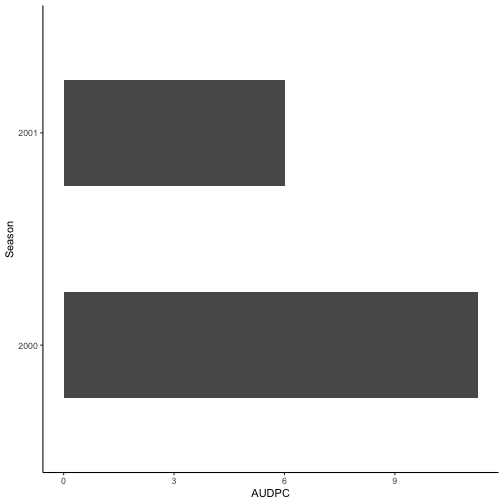
Simulating multiple seasons with {furrr} using parallel processing
Using {furrr}, we can do the same thing in parallel to reduce the runtime, especially if you have several seasons.
A note on the use of parallel processing
Use parallel processing with caution. {epicrop} is highly optimised for speed (as much as pure R can be). For small runs, e.g. one or two seasons or locations, this is will not reduce the time and may increase the run time due to overhead setting up and running the parallel processing. Best guess is that unless you have > 40 or 50 seasons or locations or some combinations thereof; to run the processes in parallel will not be any benefit.
In this case, while this code runs, you can benchmark it and see that this is no faster and in some cases, slower than running the code sequentially. An example benchmarking different methods is provided here.
library(epicrop)
library(furrr)
library(dplyr)
library(lubridate)
library(pander)
# Respect the API server and use 1 core
plan(multisession, workers = 1)
years <- 2000:2001
seasons <- paste0(years, "-06-30")
seasons_wth <-
future_map(
.x = seasons,
.f = get_wth,
lonlat = c(121.255669, 14.16742),
duration = 120,
.options = furrr_options(seed = NULL)
)
#> No encoding supplied: defaulting to UTF-8.
#> No encoding supplied: defaulting to UTF-8.
#> No encoding supplied: defaulting to UTF-8.
#> No encoding supplied: defaulting to UTF-8.
# for local processing use 2 cores, this will assign one to each year, if you
# have more years and more cores, e.g., an HPC, explore using more resources
plan(multisession, workers = 2)
# run bacterial_blight() over the data frames of weather
future_map_dfr(
.x = seasons_wth,
.f = ~ bacterial_blight(emergence = .x$YYYYMMDD[1],
wth = .x),
.options = furrr_options(seed = NULL)
) |>
mutate(season = case_when(year(dates) == 2000 ~ 2000,
year(dates) == 2001 ~ 2001)) |>
group_by(season) |>
relocate(season, AUDPC) |>
distinct(AUDPC, season) |>
pander()| AUDPC | season |
|---|---|
| 11.25 | 2000 |
| 6.022 | 2001 |
We can see here that the AUDPC values match using both processing methods.
Multiple establishment dates
Using {purrr} to simulate multiple establishment dates
To simulate multiple establishment dates and across multiple years at
the same time we can use purrr::expand_grid() to create a
vector of all year and month-day combinations that we wish to
simulate.
Simplifying the weather data, we will only use the first date of each
year and fetch weather data using the duration option,
specifying 180 days. This gives six months of data and extends to the
end and a bit beyond the last growing season of the final establishment
date, “01-31”. bacterial_blight() will take the full six
months of weather data and subset for the respective growing seasons,
selecting only the necessary weather data.
Using purrr::map2 allows for using two variables, one
for weather data, wth, and one for the
emergence/establishment dates, emergence_dates. This
returns a list of data, but using
dplyr::bind_rows(.id = "emergence") creates a data frame
with a column of emergence/establishment dates that can be used for
grouping the data for further analysis or visualisation.
library(epicrop)
library(purrr)
library(dplyr)
library(lubridate)
library(pander)
library(furrr)
library(tidyr)
years <- as.character(2001:2010)
month_day <- c("-06-01", "-06-14", "-06-30")
emergence_dates <-
expand_grid(years, month_day) |>
unite("emergence_dates", years:month_day, sep = "") |>
pull(emergence_dates) |>
sort() |>
as_date()
# Respect the API server and use 1 core
plan(multisession, workers = 1)
# create a vector of dates for weather data.
# Only take the earliest establishment date, then extend the duration out past
# 120 days from final establishment date.
# Here just taking 180 days, 6 months, works well.
wth_start_dates <- paste0(years, month_day[1])
seasons_wth <- map_dfr(
.x = wth_start_dates,
.f = get_wth,
lonlat = c(121.255669, 14.16742),
duration = 180
) |>
mutate(YYYYMMDD = as_date(YYYYMMDD))
#> No encoding supplied: defaulting to UTF-8.
#> No encoding supplied: defaulting to UTF-8.
#> No encoding supplied: defaulting to UTF-8.
#> No encoding supplied: defaulting to UTF-8.
#> No encoding supplied: defaulting to UTF-8.
#> No encoding supplied: defaulting to UTF-8.
#> No encoding supplied: defaulting to UTF-8.
#> No encoding supplied: defaulting to UTF-8.
#> No encoding supplied: defaulting to UTF-8.
#> No encoding supplied: defaulting to UTF-8.
#> No encoding supplied: defaulting to UTF-8.
#> No encoding supplied: defaulting to UTF-8.
#> No encoding supplied: defaulting to UTF-8.
#> No encoding supplied: defaulting to UTF-8.
#> No encoding supplied: defaulting to UTF-8.
#> No encoding supplied: defaulting to UTF-8.
#> No encoding supplied: defaulting to UTF-8.
#> No encoding supplied: defaulting to UTF-8.
#> No encoding supplied: defaulting to UTF-8.
#> No encoding supplied: defaulting to UTF-8.
# Now use 4 cores for the local processing
plan(multisession, workers = 4)
# Once we have all the weather, create a list of weather data.frames for each
# establishment date
# Create time intervals to subset the weather data, creating a list new
# data.frames for each establishment date.
wth <-
map(.x = emergence_dates,
.f = ~ subset(seasons_wth, YYYYMMDD >= .x &
YYYYMMDD <= .x + 120)) |>
setNames(emergence_dates)
multi_dates <- map2(
.x = wth,
.y = emergence_dates,
.f = ~ bacterial_blight(emergence = .y,
wth = .x)
) |>
bind_rows(.id = "emergence") |>
group_by(emergence) |>
relocate(emergence, AUDPC) |>
distinct(AUDPC, emergence)
pander(multi_dates)| AUDPC | emergence |
|---|---|
| 11.9 | 2001-06-01 |
| 7.111 | 2001-06-14 |
| 6.022 | 2001-06-30 |
| 12.59 | 2002-06-01 |
| 10.58 | 2002-06-14 |
| 12.25 | 2002-06-30 |
| 10.28 | 2003-06-01 |
| 10.7 | 2003-06-14 |
| 15.41 | 2003-06-30 |
| 10.44 | 2004-06-01 |
| 13.45 | 2004-06-14 |
| 10.31 | 2004-06-30 |
| 13.93 | 2005-06-01 |
| 13.41 | 2005-06-14 |
| 15.25 | 2005-06-30 |
| 15.22 | 2006-06-01 |
| 14.16 | 2006-06-14 |
| 12.74 | 2006-06-30 |
| 7.917 | 2007-06-01 |
| 7.269 | 2007-06-14 |
| 11.02 | 2007-06-30 |
| 9.418 | 2008-06-01 |
| 9.072 | 2008-06-14 |
| 10.38 | 2008-06-30 |
| 4.917 | 2009-06-01 |
| 9.179 | 2009-06-14 |
| 6.911 | 2009-06-30 |
| 14.08 | 2010-06-01 |
| 16.44 | 2010-06-14 |
| 16.13 | 2010-06-30 |
That’s a bit long and there’s lots of values to digest here.
Visualising multiple establishment dates using a stem plot
A bar chart as with the previous example works, but it can be
simplified and made more clear using a stem plot created with
ggplot2. Using ggplot2::geom_segment() and
ggplot2::geom_point() we can maximise the ink to
information ratio and create an easy to view and interpret graph of
these data.
Note the additional ggplot2::aes() parameters here,
xend and yend are necessary since we’re using
ggplot2::geom_segment().
library(ggplot2)
ggplot(data = multi_dates,
aes(
x = AUDPC,
xend = 0,
y = as.factor(emergence),
yend = as.factor(emergence)
)) +
geom_segment() +
geom_point() +
scale_x_continuous(expand = expansion(mult = c(0, 0.1))) +
scale_y_discrete(limits = rev) +
ylab("Establishment Date") +
theme_classic()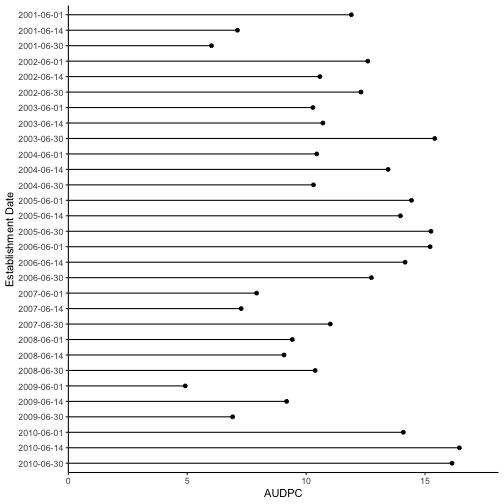
Using {furrr} to run multiple establishment dates in parallel
To run the previous example in parallel, substitute {furrr}
equivalent functions for the {purrr} functions used above. These are
easily identified by the future_ prefix on each of the
functions where they are used.
In this example rather than printing the whole table, the data are
piped directly into the ggplot2::ggplot() function for
creating a figure that again, is the same as the previous example, but
run in parallel using {furrr}.
library(furrr)
library(purrr)
library(tidyr)
library(dplyr)
library(ggplot2)
library(lubridate)
library(epicrop)
plan(multisession, workers = 1)
years <- 2001:2010
month_day <- c("06-01", "06-14", "06-30")
start_dates <- list(years, month_day, sep = "-")
emergence_dates <-
tidyr::expand_grid(!!!start_dates) |>
pmap_chr(paste) |>
sort() |>
as_date()Now, create a vector of dates for weather data. Only take the earliest establishment date, then extend the duration out past 120 days from final establishment date. Here just taking 180 days, 6 months, works well.
wth_start_dates <- paste(years, month_day[1], sep = "-")
seasons_wth <-
future_map_dfr(
.x = wth_start_dates,
.f = get_wth,
lonlat = c(121.255669, 14.16742),
duration = 190,
.options = furrr_options(seed = NULL)
) |>
mutate(YYYYMMDD = as_date(YYYYMMDD))
#> No encoding supplied: defaulting to UTF-8.
#> No encoding supplied: defaulting to UTF-8.
#> No encoding supplied: defaulting to UTF-8.
#> No encoding supplied: defaulting to UTF-8.
#> No encoding supplied: defaulting to UTF-8.
#> No encoding supplied: defaulting to UTF-8.
#> No encoding supplied: defaulting to UTF-8.
#> No encoding supplied: defaulting to UTF-8.
#> No encoding supplied: defaulting to UTF-8.
#> No encoding supplied: defaulting to UTF-8.
#> No encoding supplied: defaulting to UTF-8.
#> No encoding supplied: defaulting to UTF-8.
#> No encoding supplied: defaulting to UTF-8.
#> No encoding supplied: defaulting to UTF-8.
#> No encoding supplied: defaulting to UTF-8.
#> No encoding supplied: defaulting to UTF-8.
#> No encoding supplied: defaulting to UTF-8.
#> No encoding supplied: defaulting to UTF-8.
#> No encoding supplied: defaulting to UTF-8.
#> No encoding supplied: defaulting to UTF-8.Once we have all the weather, create a list of weather
data.frames for each establishment date. Create time
intervals to subset the weather data, creating a list new
data.frames for each establishment date.
# Now use 4 cores for the local processing
plan(multisession, workers = 4)
wth <-
future_map(.x = emergence_dates,
.y = seasons_wth,
.f = ~ subset(.y, YYYYMMDD >= .x &
YYYYMMDD <= .x + 120)) |>
setNames(emergence_dates)
future_map2(
.x = wth,
.y = emergence_dates,
.f = ~ bacterial_blight(emergence = .y,
wth = .x),
.options = furrr_options(seed = NULL)
) |>
bind_rows(.id = "emergence") |>
group_by(emergence) |>
relocate(emergence, AUDPC) |>
distinct(AUDPC, emergence) |>
ggplot(aes(
x = AUDPC,
xend = 0,
y = as.factor(emergence),
yend = as.factor(emergence)
)) +
geom_segment() +
geom_point() +
scale_x_continuous(expand = expansion(mult = c(0, 0.1))) +
scale_y_discrete(limits = rev) +
ylab("Establishment Date") +
theme_classic()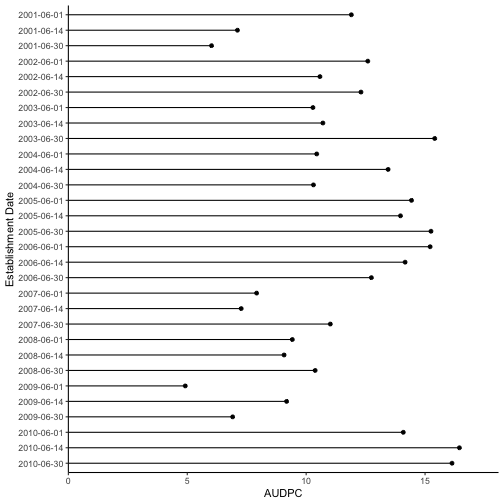
Multiple locations
Using {purrr} to simulate multiple locations
Multiple locations will look much like the previous example for
multiple seasons (years) but a vector of latitude and longitude values
are provided to get_wth(). In this example we will fetch
data for the Mekong River Delta and Red River Delta in Vietnam; Prachin
Buri, Thailand; Chennai, India and Nueva Ecija, in the Philippines for
the wet season (second half of the year) in 2000.
locations <- list(
"Mekong River" = c(105.5943, 10.0634),
"Red River" = c(105.9700, 20.9034),
"Prachin Buri" = c(101.6601, 14.0421),
"Chennai" = c(80.2707, 13.0827),
"Neuva Ecija" = c(121.1113, 15.5784)
)Next use get_wth() to fetch the weather data from the POWER API. With the list of
locations, locations, use purrr::map() to
fetch all of the locations with one function. You could also use R’s
base lapply() here as well if you prefer.
library(epicrop)
library(purrr)
locations_wth <-
map(
.x = locations,
.f = get_wth,
dates = "2000-06-30",
duration = 120
)
#> No encoding supplied: defaulting to UTF-8.
#> No encoding supplied: defaulting to UTF-8.
#> No encoding supplied: defaulting to UTF-8.
#> No encoding supplied: defaulting to UTF-8.
#> No encoding supplied: defaulting to UTF-8.
#> No encoding supplied: defaulting to UTF-8.
#> No encoding supplied: defaulting to UTF-8.
#> No encoding supplied: defaulting to UTF-8.
#> No encoding supplied: defaulting to UTF-8.
#> No encoding supplied: defaulting to UTF-8.Simulating multiple locations with {purrr}
This behaviour would be the same as if you used R’s base
lapply() here as well. The process for using {furrr} won’t
be shown here, but to implement several locations or year locations and
planting date simulations in parallel would be as shown above.
library(dplyr)
library(lubridate)
library(ggplot2)
map(
.x = locations_wth,
.f = ~ bacterial_blight(emergence = .x$YYYYMMDD[1],
wth = .x)
) |>
bind_rows(.id = "location") |>
group_by(location) |>
relocate(location, AUDPC) |>
distinct(AUDPC, location) |>
ggplot(aes(
x = AUDPC,
xend = 0,
y = as.factor(location),
yend = as.factor(location)
)) +
geom_segment() +
geom_point() +
scale_x_continuous(expand = expansion(mult = c(0, 0.1))) +
scale_y_discrete(limits = rev) +
ylab("Location") +
theme_classic()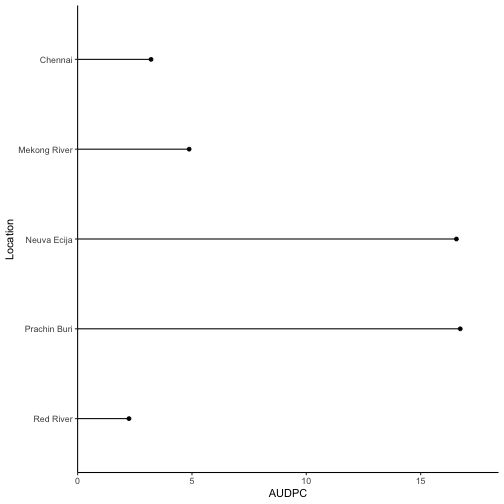
Benchmarking sequential versus parallel methods
It is possible to measure the effect of running the simulations in parallel as compared to sequentially using the {microbenchmark} package. Here an example of how to use benchmarking is shown using the second set of examples showing how to simulate multiple establishment dates with the already created objects from those examples.
Greater gains in efficiency will be realised with more dates, locations, etc. when running in parallel than sequentially.
library(microbenchmark)
plan(multisession, workers = 4)
mbm <- microbenchmark(
sequential = map2(
.x = wth,
.y = emergence_dates,
.f = ~ bacterial_blight(emergence = .y,
wth = .x)
) |>
bind_rows(.id = "emergence"),
parallel = future_map2(
.x = wth,
.y = emergence_dates,
.f = ~ bacterial_blight(emergence = .y,
wth = .x),
.options = furrr_options(seed = NULL)
) |>
bind_rows(.id = "emergence"),
times = 100L
)
mbm
#> Unit: milliseconds
#> expr min lq mean median uq max neval
#> sequential 47.06866 50.55653 54.12912 52.07023 57.30681 71.20413 100
#> parallel 229.02592 241.50166 245.45066 243.49016 246.69370 408.28969 100
autoplot(mbm) +
theme_classic()